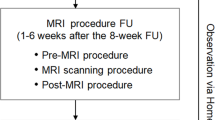Abstract
Purpose
To determine the current incidence of antitachycardia therapy suspension due to magnet reversion in patients with implantable cardioverter defibrillators (ICDs).
Methods
From March 2012 to September 2018, all St. Jude Medical ICD interrogations performed at the Deutsches Herzzentrum München were screened for stored events of antitachycardia therapy suspension caused by static magnetic fields (flux densities ≥ 1 mT as defined in St. Jude Medical ICDs) affecting the giant magnetoresistance (GMR) sensor. Intentional ICD deactivation or inappropriate magnet application in the hospital was classified as non-environmental electromagnetic interference (EMI) whereas in the case of any other stored magnet reversion, the event was classified as presumably environmental EMI.
Results
Data from 201 St. Jude Medical ICD patients (mean age 62 ± 24 years, 165 males/36 females) were included in the analysis. ICD interrogations occurred at a mean follow-up of 25.1 months ± 15.6 months and summed up to a total of 464 patient-years of follow-up. A total number of 43 magnet reversion events were detected in 21 patients. Thirty-two events in 13 patients were presumably related to environmental EMI sources. Suspension of antitachycardia therapy only occurred in a temporary fashion. None of the patients experienced any ventricular tachyarrhythmia during ICD inhibition. The incidence of antitachycardia therapy suspension due to magnet reversion related to presumably environmental EMI sources was 6.9% per patient and year.
Conclusion
Although none of the patients experienced any harmful event, antitachycardia therapy suspension due to magnet reversion is a common issue. Patients should be well-educated about potential EMI sources as well as trained in handling them.

Similar content being viewed by others
References
Kadish A, Dyer A, Daubert JP, Quigg R, Estes NA, Anderson KP, et al. Prophylactic defibrillator implantation in patients with nonischemic dilated cardiomyopathy. N Engl J Med. 2004;350(21):2151–8. https://doi.org/10.1056/NEJMoa033088.
Kuck KH, Cappato R, Siebels J, Ruppel R. Randomized comparison of antiarrhythmic drug therapy with implantable defibrillators in patients resuscitated from cardiac arrest : the Cardiac Arrest Study Hamburg (CASH). Circulation. 2000;102(7):748–54.
Moss AJ, Zareba W, Hall WJ, Klein H, Wilber DJ, Cannom DS, et al. Prophylactic implantation of a defibrillator in patients with myocardial infarction and reduced ejection fraction. N Engl J Med. 2002;346(12):877–83. https://doi.org/10.1056/NEJMoa013474.
Banks H, Torbica A, Valzania C, Varabyova Y, Prevolnik Rupel V, Taylor RS, et al. Five year trends (2008-2012) in cardiac implantable electrical device utilization in five European nations: a case study in cross-country comparisons using administrative databases. Europace. 2018;20(4):643–53. https://doi.org/10.1093/europace/eux123.
Pinski SL, Trohman RG. Interference in implanted cardiac devices, Part I. Pacing Clin Electrophysiol. 2002;25(9):1367–81.
Beinart R, Nazarian S. Effects of external electrical and magnetic fields on pacemakers and defibrillators: from engineering principles to clinical practice. Circulation. 2013;128(25):2799–809. https://doi.org/10.1161/CIRCULATIONAHA.113.005697.
Jacob S, Panaich SS, Maheshwari R, Haddad JW, Padanilam BJ, John SK. Clinical applications of magnets on cardiac rhythm management devices. Europace. 2011;13(9):1222–30. https://doi.org/10.1093/europace/eur137.
Kolb C, Zrenner B, Schmitt C. Incidence of electromagnetic interference in implantable cardioverter defibrillators. Pacing Clin Electrophysiol. 2001;24(4 Pt 1):465–8.
Occhetta E, Bortnik M, Magnani A, Francalacci G, Marino P. Inappropriate implantable cardioverter-defibrillator discharges unrelated to supraventricular tachyarrhythmias. Europace. 2006;8(10):863–9. https://doi.org/10.1093/europace/eul093.
von Olshausen G, Rondak IC, Lennerz C, Semmler V, Grebmer C, Reents T, et al. Electromagnetic interference in implantable cardioverter defibrillators: present but rare. Clin Res Cardiol. 2016;105(8):657–65. https://doi.org/10.1007/s00392-016-0965-1.
Lee S, Fu K, Kohno T, Ransford B, Maisel WH. Clinically significant magnetic interference of implanted cardiac devices by portable headphones. Heart Rhythm. 2009;6(10):1432–6. https://doi.org/10.1016/j.hrthm.2009.07.003.
Tiikkaja M, Aro A, Alanko T, Lindholm H, Hietanen M. Inappropriate implantable cardioverter-defibrillator magnet-mode switch induced by a laptop computer. Pacing Clin Electrophysiol. 2012;35(6):e177–8. https://doi.org/10.1111/j.1540-8159.2012.03330.x.
Schmitt C, Brachmann J, Waldecker B, Navarrete L, Beyer T, Pfeifer A, et al. Implantable cardioverter defibrillator: possible hazards of electromagnetic interference. Pacing Clin Electrophysiol. 1991;14(6):982–4.
Kolb C, Deisenhofer I, Weyerbrock S, Schmieder S, Plewan A, Zrenner B, et al. Incidence of antitachycardia therapy suspension due to magnet reversion in implantable cardioverter defibrillators. Pacing Clin Electrophysiol. 2004;27(2):221–3.
Wolber T, Ryf S, Binggeli C, Holzmeister J, Brunckhorst C, Luechinger R, et al. Potential interference of small neodymium magnets with cardiac pacemakers and implantable cardioverter-defibrillators. Heart Rhythm. 2007;4(1):1–4. https://doi.org/10.1016/j.hrthm.2006.09.012.
Acknowledgements
We thank K. Hester, M. Lange, M. Lösel, S. Pilz, H. Sandler, G. Urgibl, S. Wolf, and A. Santos for their invaluable support in the ICD outpatient clinic.
Author information
Authors and Affiliations
Corresponding author
Ethics declarations
Conflict of interest
G. v. O. has received educational and travel support from Boston Scientific. C. G. has received travel support from Abbott, Biotronik, and Medtronic. P. B. has received travel support from Abbott and Biotronik and lecture honorary from Biotronik. V. S. has received travel support from Sorin Group, Boston Scientific, and St Jude Medical; educational grant from Boston Scientific and St. Jude Medical; and study grant from Sorin Group. C. K. has received travel support and/or lecture honorary from Biotronik, Boston Scientific, Microport, Medtronic, and Abbott; has received study funding from Abbott, Biotronik, Boston Scientific, and Microport; and has served as advisor for Biotronik and Microport. C.L. reports grants from Bavarian Ministry of Economic Affairs, Regional Development and Energy, and has received travel support and lecture honorary from Biotronik, Boston Scientific, Medtronic, and Abbott. For the remaining authors, no conflicts of interest are declared.
Ethical approval
The study design was approved by the local ethics committee of the Technische Universität München and patient data were collected in accordance with the institutional ethics guidelines.
Additional information
Publisher’s note
Springer Nature remains neutral with regard to jurisdictional claims in published maps and institutional affiliations.
Rights and permissions
About this article
Cite this article
von Olshausen, G., Schorr, J., Grebmer, C. et al. Incidence of magnet mode in patients with implantable cardioverter defibrillators. J Interv Card Electrophysiol 56, 335–339 (2019). https://doi.org/10.1007/s10840-019-00637-5
Received:
Accepted:
Published:
Issue Date:
DOI: https://doi.org/10.1007/s10840-019-00637-5




